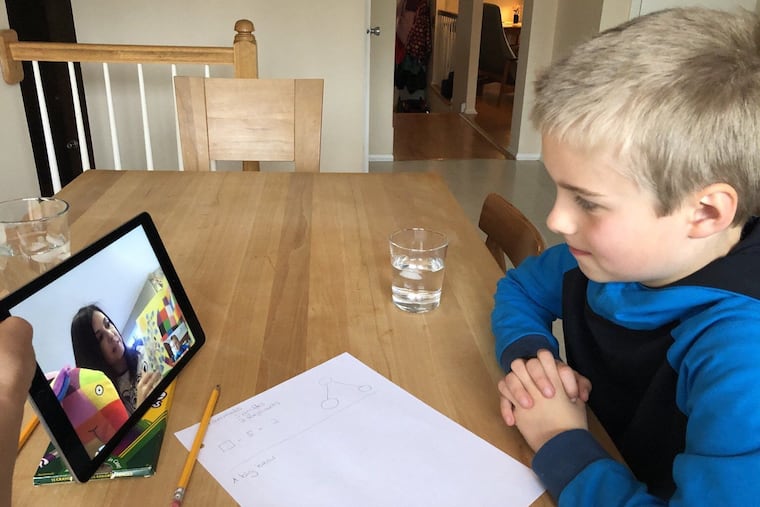How teachers are using technology to keep in touch with students during coronavirus school closures
By 9 a.m., Jill Hammel’s kindergarteners can log in online to get their assignments. Twice a week, they get special time individually with her to read a favorite story and share their new normalcy outside of the classroom.

Kindergarten teacher Jill Hammel is keeping up with her class: Emily has a loose tooth that could fall out any day; Angelo’s little brother took his first steps; Sammy has a new betta fish; and Piet made chocolate chip cookies.
Schools may be shut down by the coronavirus, but the Cherry Hill educator is using technology to teach remotely by posting assignments online every morning and chatting with students via FaceTime to give them a new sense of normalcy.
With the pandemic disrupting classroom learning across the region and around the world, teachers are trying to keep instruction going and staying connected to their students during a hiatus that could last weeks and possibly longer. Some have come up with unique distance learning techniques, from rap videos to story time.
In Philadelphia, where few students have access to laptops and devices, the district created learning guides for various subjects. On Monday, it added nine new hotlines in 10 languages to answer questions from families in their native language, including Russian, Spanish and Vietnamese.
Hammel, a full-day kindergarten teacher at James F. Cooper Elementary, shares lesson plans with her 21 students on Google Classroom, sends photographs and videos, and talks to parents — some every day. She also uses ClassDoJo, a messaging app. She may soon add a Zoom meeting so the entire class can log in simultaneously via video conference or phone.
She relies heavily on Google Classroom, a free app that allows students to access 20-minute assignments from a computer or mobile device. Teachers can track student progress, grade coursework, and provide feedback.
Hammel’s students were already accustomed to using online learning in the classroom, so the transition has been relatively smooth, with only a few technical glitches. Parents, many juggling working remotely at home, are playing the role of teacher.
“We’re all learning together,” Hammel said.
By the time the virtual school day begins at 9 a.m., Hammel has posted the day’s assignments on Google Classroom. On Monday, she began with a message: “I miss you all and can’t wait until we are back in school together.” She instructed students to read I Will Take a Nap! and answer questions, write in a journal, complete math problems, and do a hands-on creative activity.
Hammel also does birthday shout-outs, reads aloud, and answers questions virtually from students and parents. They send videos and dozens of photos to her, too that she shares with the entire class and via social media. Hammel also uses old-fashioned phone calls and FaceTime, Apple’s video and calling service, to connect virtually with her students and their parents.
During the first week of distance learning, Hammel called every family twice. The conversations were partly academic, partly social and personal. For most calls, she asked the student to select a favorite classroom book aloud via Facebook. Students share what’s happening in their lives — something they typically do at school during circle time.
Angelo Cabello, 5, was proud to inform Hammel that his 18-month-old brother, Sal, took four steps. “I know how to read,” he said excitedly.
His mother, Christine, said she maintains a normal school day, although Angelo gets easily distracted. Hammel’s assignments help keep Angelo focused, and she added handwriting and math workbooks.
“He misses school. He wants to see his friends,” said Cabello, 36, an academic coordinator at Children’s Hospital of Philadelphia. Hammel choked up, and tried to reassure Angelo that the class “will be together again very soon.”
Sammy Klein asked Hammel to read “Elmo,” which she did for the fourth time that day. She wished Emily Dworkin, 5, and her twin, Samantha, happy birthday, and told Emily to let her know when her tooth falls out so it could be added to the class tooth tally. Sienna Pacitti, 5, said she was “mad” about the school closure.
“We want them to feel cared for at a time when their lives are changing,” said Hammel.
To connect with her students, Jacki Tiger, a fourth-grade teacher at Hurffville Elementary in Washington Township, has turned her washer and dryer into a whiteboard. She writes on the appliances and livestreams math lessons. She has dubbed the instruction “Live From the Laundry Pile!”
Elsewhere in South Jersey, Carrie Merritt, a first-grade teacher at the Ocean City Primary School, reads a story and dresses up as a character from the book of the day. Her “Read Aloud” lessons are uploaded to YouTube and distributed on the school’s website.
“This is a fun way to get to kids,” said Merritt. “It’s just cool.”
Shannon Smith has become known as the Prince(ipal) of Barnegat at Russell O. Brackman Middle School after she made a rap video to the tune of Will Smith’s ’90s hit, “Fresh Prince of Bel-Air.” School staff got into the fun and music teacher Erich Wald produced the song.
Smith said a social studies teacher had his students create a rap using their vocabulary words as an enrichment activity. The school, which enrolls nearly 750 sixth through eighth graders, uses Group Meet for math so students can view the lessons online, she said.
“They’re making it fun," Smith said. “My message to students and teachers is that we will get through this one step at a time — together.”